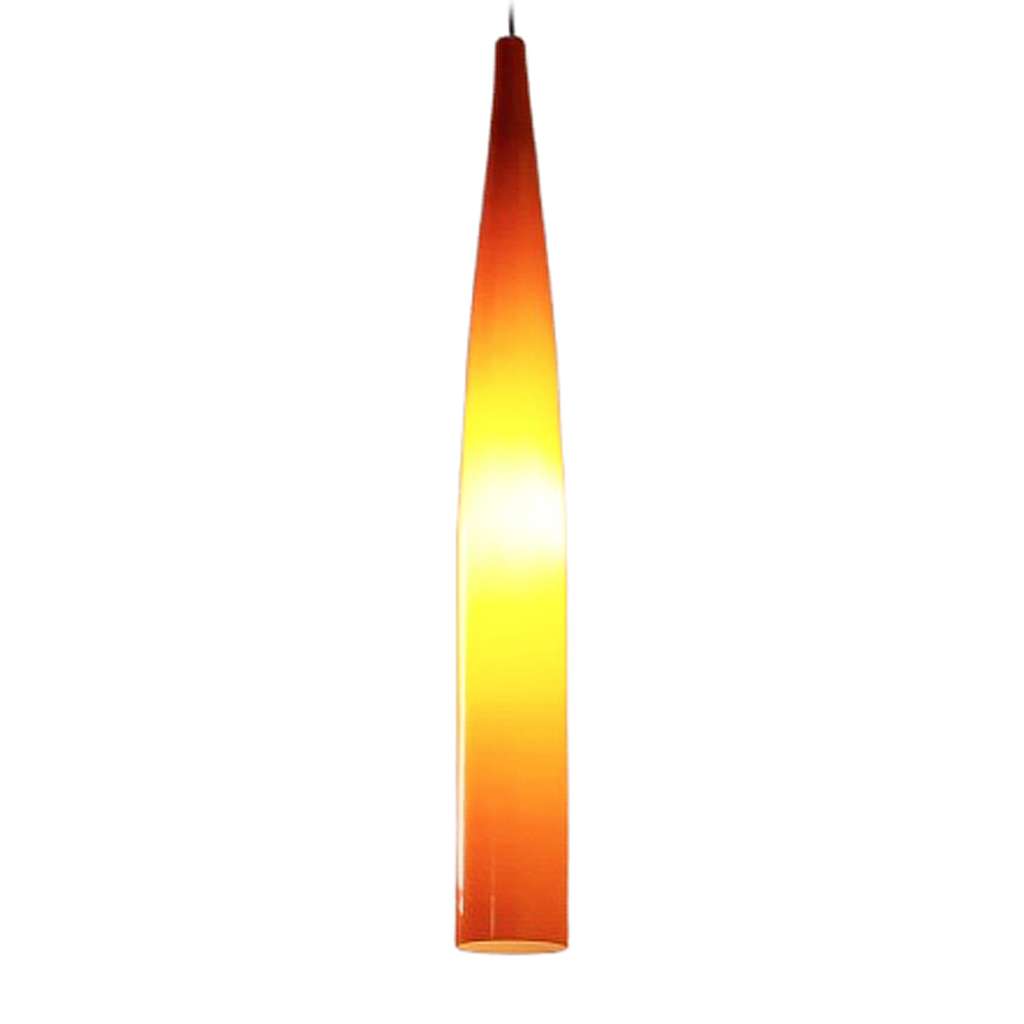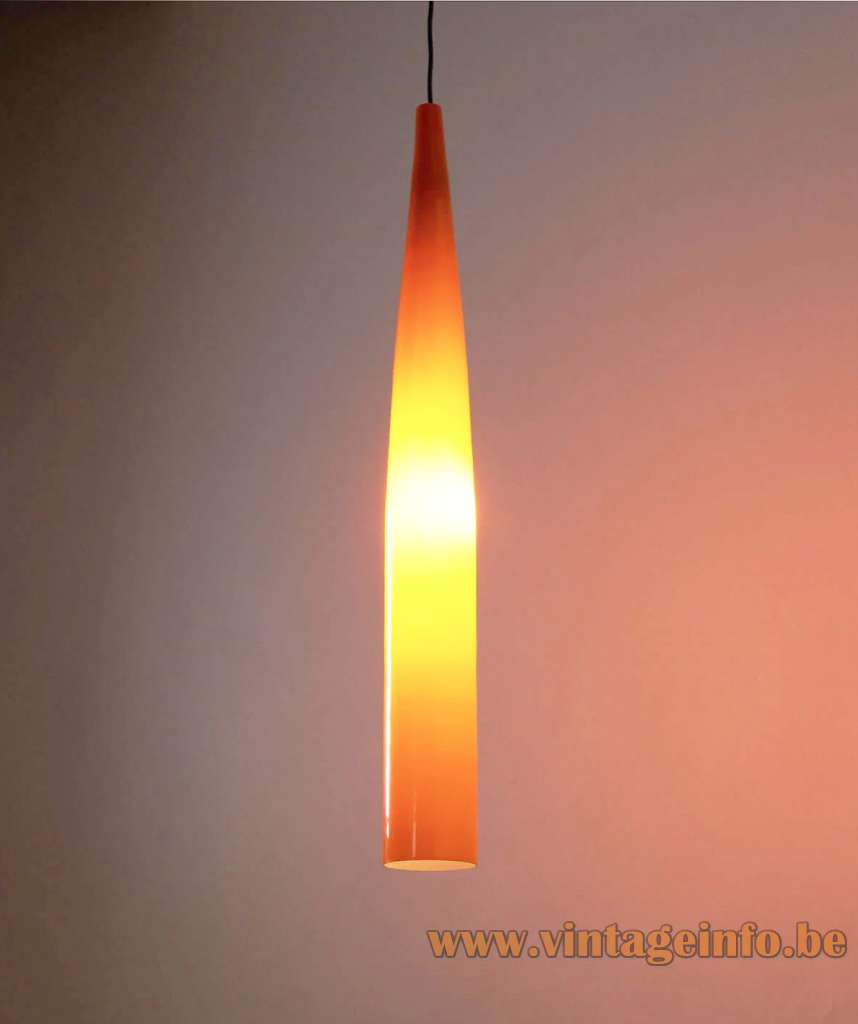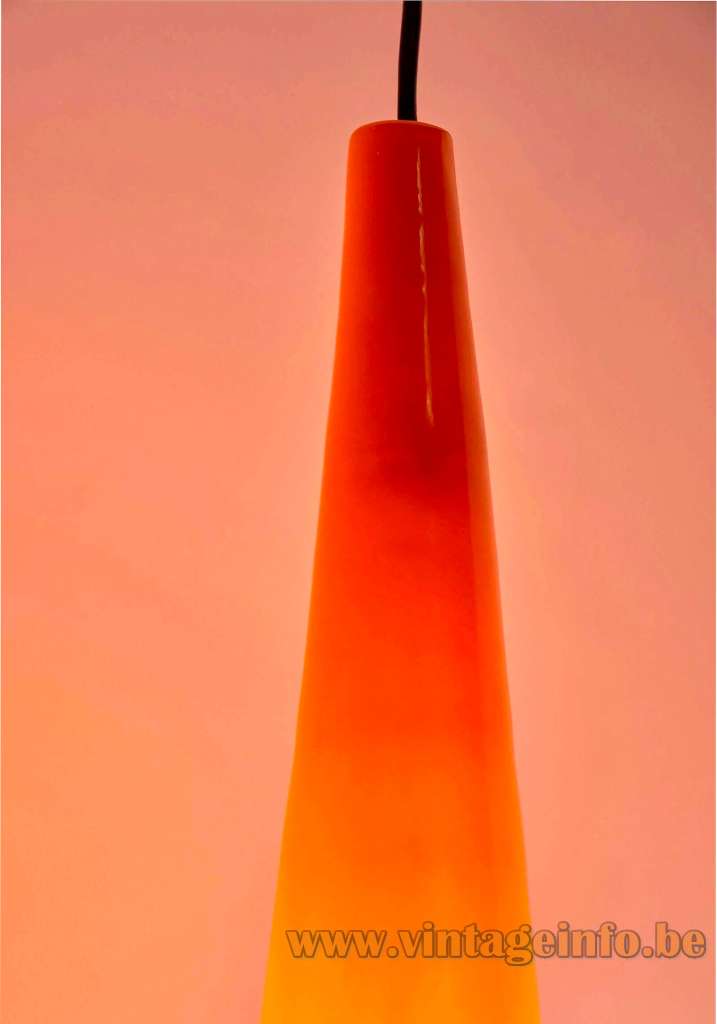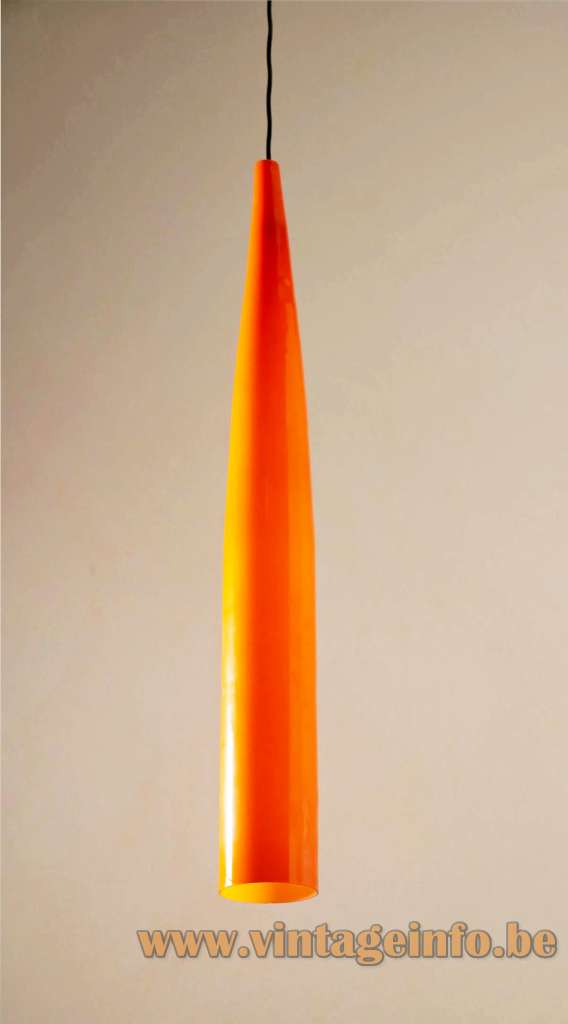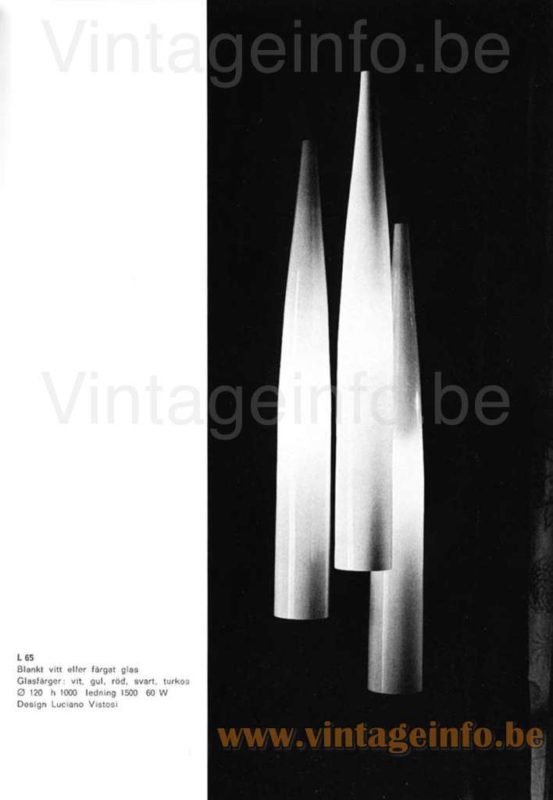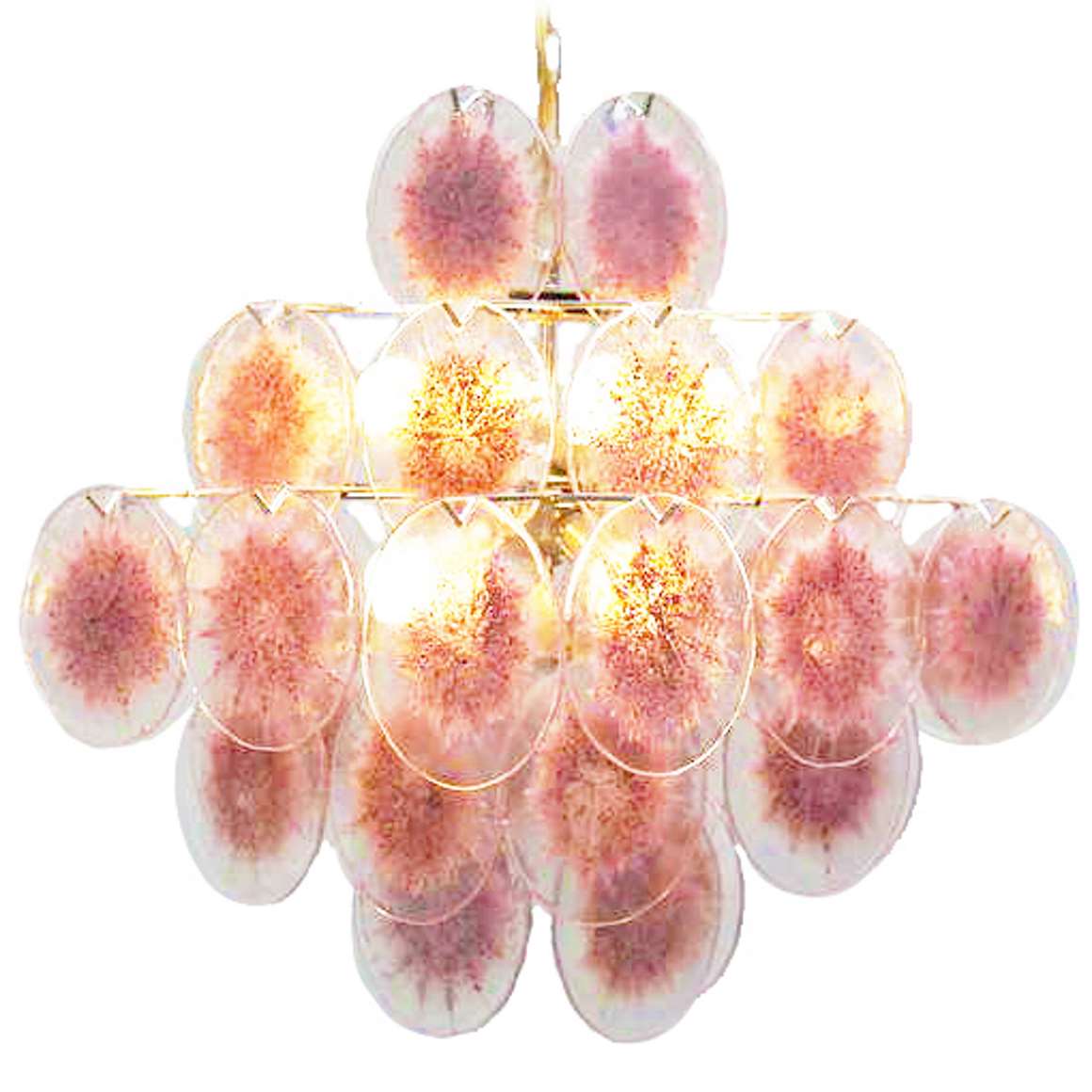Vistosi L65 Tube Pendant Lamp – 1965 Lilux Catalogue Picture
This Vistosi L65 tube pendant lamp, designed by Luciano Vistosi, appear in a 1965 Lilux catalogue. You can find this catalogue over here, on Vintageinfo. At that time, Lilux sold a wide range of Vistosi lamps.
Translated text from this catalogue picture:
L 65
Glossy white or coloured glass
Glass colours: white, yellow, red, black, turquoise
Ø 120 h 1000 cable 1500 60 W
Design Luciano Vistosi
Video: Masters of Murano
A portrait of the master glass makers Luciano Vistosi, Lino Tagliapietra and Alfredo Barbini. After a brief view of Venice and Murano, the three artists are displayed in the workplace. Lino Tagliapietra is shown together with sticks, Luciano Vistosi makes a plate and Alfredo Barbini makes a bowl with the use of sticks. While working, all artists discuss their work.
Video: Expo Luciano Vistosi
Luciano Vistosi Exhibition in Murano.
Video: Luciano Vistosi’s Munega
Vistosi promo for the Munega, a similar lamp as the Nessa by Luciano Vistosi and how it is made in the glassworks.
Links (external links open in a new window)
Vistosi history – Vistosi website
Luciano Vistosi – Murano Glass Museum
Vintageinfo
Many thanks to Max from AfterMidnight for the pictures.
Vistosi L65 Tube Pendant Lamp
Materials: Round long red-orange hand-blown pipe style Murano glass lampshade. Some metal parts Bakelite E27 lamp socket.
Cord: 100 cm / 39.37”
Height: 103 cm / 40.55”
Width: ∅ 12,5 cm / 4.92”
Electricity: 1 bulb E27, 1 x 60 watt maximum, 110/220 volt.
Any type of light bulb can be used, but preferably a white/opaque bulb.
Period: 1960s, 1970s – Mid-Century Modern.
Designer: Luciano Vistosi.
Manufacturer:Vistosi, Murano, Italy.
Other versions: This Vistosi L65 tube pendant lamp comes in several colours and small variations in size. The standard size is 100 cm / 39.37” long and 12 cm / 4.72” wide. At least made in white, yellow, red, black and turquoise.
You regularly see this Vistosi L65 tube pendant lamp offered for sale with the designer listed as Gino Vistosi, Alessandro Pianon or Peter Pelzel. Sometimes Michael Red is mentioned as the designer. The latter is correct, as this was the pseudonym used by Luciano Vistosi at the time. In the Lilux catalogue, Luciano Vistosi is credited, but it is quite possible that other catalogues listed Michael Red instead, although I have not yet come across one.
This Vistosi L65 pendant lamp is often called Ombrello, the Italian word for umbrella. The reason is understandable, but it’s probably a fabrication. It’s not listed like that in a catalogue.
Luciano Vistosi
“…At home, I rarely heard anyone speak of sculpture: we would only talk about painting. And yet, the forms were there: they were created every day in the furnace. I might say that I have always thought three-dimensionally, in a sculptural way.” (Luciano Vistosi, 2003)
Luciano Vistosi (24 February 1931, Murano – 14 May 2010, Venice) was an Italian glass designer and sculptor closely associated with the post-war renaissance of Murano glass. Born in Venice and raised on the island of Murano, he grew up in his family’s glassworks, where he learned the craft from an early age and became fascinated by the possibilities of molten glass.
After his father’s death in 1952, Vistosi interrupted his studies and, together with his uncle Oreste and his brother Gino, founded the new Vetreria Vistosi. Their aim was to move beyond traditional tourist wares and create glass objects and lighting that reflected the most up-to-date developments in modern design.
As artistic director, Luciano pushed the company in a distinctly contemporary direction, designing many pieces himself and inviting leading architects and designers such as Vico Magistretti, Ettore Sottsass, Marco Zanuso and Gae Aulenti to collaborate.
Vistosi’s own work is marked by a constant search for “absolute” forms and an insistence on the primacy of material over drawing. Being left-handed, he often had to modify tools and working methods to suit his way of handling glass, which encouraged further experimentation. His lamps, vases and everyday objects from the 1950s to the 1970s combine technical sophistication with soft, sculptural lines.
Some of his designs were produced under the pseudonym Michael Red, a name that appears in period catalogues and on pieces such as the Nessa and Galia lamps for Vistosi.
From the late 1960s onward, Vistosi increasingly devoted himself to glass sculpture. His first solo exhibition, held in 1968 at the Galleria Alfieri in Venice, already revealed a mature sculptor with a very personal language. Subsequent solo shows followed in San Francisco, Venice, Cologne and Düsseldorf, and in the early 1980s the Ca’ Pesaro Museum of Modern Art in Venice dedicated a large retrospective to his work, followed by exhibitions in Madrid, Florence, Segovia and Milan.
While he is widely known among design collectors for lighting such as the Onfale table lamp for Artemide (designed in 1978 and still in production today), Vistosi’s later career was dominated by ambitious one-off sculptures in blown and carved glass, sometimes conceived on an architectural scale. In 1994 he created a monumental glass cross, composed of green, lagoon-coloured blocks supported on a bronze stele, for the crypt of the Basilica di San Marco in Venice. He also developed visionary bridge projects in glass and took part in major international exhibitions, including the Venice Biennale and the São Paulo Biennial.
Despite serious illness in his later years, Luciano Vistosi continued to work in his Murano studio until shortly before his death in Venice in 2010. He often remarked that, although his family mostly talked about painting, the true “forms” were born every day in the furnace, and that he had always thought in three dimensions—an attitude that runs through both his lighting designs and his glass sculpture.
For Vistosi he designed, among others, the following lamps:
As “Michael Red” (pseudonym of Luciano Vistosi):
Bovolo and Bovolin – large and small table lamps that are often incorrectly offered on the market under the name Monaco, Monacella and a few other names. The Nonzolo table lamp model L428, the Galia, model L419 – a big table lamp. Varola table lamp. Brucco table lamp, model L285 – lamp attributed to Luciano Vistosi / Michael Red in several auction listings, although at least one old American book gives it a different name and designer: Undula and designed by Enrico Capuzzo. The design is strongly reminiscent of Luciano. Perhaps that’s why the attribution, or it’s incorrectly stated in the book.
As Luciano Vistosi:
The L 65 tubular pendant lamp on this page, documented in the Lilux catalogue. The Neverrino lamp series. Bissa and Bissona table lamps, the big Lepanto floor lamp. The famous Munega sculptural table lamp series, still for sale. The Zenda pendant lamp series produced by Vistosi, sometimes sold online as Luciano Vistosi for Venini… The Mambo table lamp, the Bragadina table lamp and the Faliera table lamp.
For Artemide he designed the Onfale series of table lamps (also produced in wall and pendant versions).
Vistosi
Early Origins
The story of Vistosi begins in Murano with the Gazzabin family, who acquired the Al Bastian furnace in 1640. Soon after, the family name “Vistosi” emerged, and by 1791Gio-Batta Vistosi had become Gastaldo dell’Arte, head of the Murano glassmakers’ guild.
A New Beginning after the War
In 1945Guglielmo Vistosi, heir of the Gazzabin family, opened a new furnace in Murano right after World War II, focusing on lighting. Following his premature death, his sons Gino and Luciano, together with their uncle Oreste, laid the foundation of the modern Vistosi company.
The Design Revolution of the 1950s–1980s
The arrival of Venetian architect Alessandro Pianon in 1956 marked a turning point. With Gino and Luciano, he transformed the company into a pioneer of innovation and modern design.
From the late 1950s to the 1980s, Vistosi collaborated with some of the most influential names in design, such as Angelo Mangiarotti, Gae Aulenti, Ettore Sottsass Jr., Massimo Vignelli, Adalberto Dal Lago, Stefania Giannotti, Elleonore Peduzzi Riva, Vico Magistretti, Michele De Lucchi and many others. This golden era produced some of the most iconic Vistosi lighting, now highly sought after by collectors.
The Moretti Era
In 1989 the brand was acquired by Murano businessman Giancarlo Moretti, who had long experience in the glass industry. His son Matteo Moretti later relaunched the company after a short closure in the 1990s, expanding it with the acquisition of brands such as Alox, G2 and Triade.
The last of the founding generation, Luciano Vistosi (1930 – 2010), devoted his later life to research and glass sculpture, leaving a lasting artistic legacy.
Innovation and Recognition since the 2000s
From the early 2000s, Vistosi entered a new phase of experimentation and recognition. Collections such as Rina, Cheope09 and Minigiogali updated traditional techniques for contemporary forms. Later came Giogali 3D, a new interpretation of the famous chandelier, and Diadema, created with a unique patented rod process. Award-winning designs like Futura, Nodo, Trepai, Jube, Sata, Stone and Armonia confirmed Vistosi ’s relevance in international design.
In 2019 the company celebrated the 50th anniversary of Giogali, and in the following years it was recognised among the 100 Eccellenze Italiane, partnered with the Venice Glass Week, and launched a Virtual Museum, e-commerce platform and LED collections.
Designers of the Contemporary Period
Under the Moretti family, Vistosi worked with a wide range of contemporary designers, including Chiaramonte & Marin, Mauro Olivieri, Barbara Maggiolo, Paolo Crepax, Monica Agnolazza, Silvio Zanon, Giovanni Barbato, Matthias Hickl, Roberto Maci, Alberto Nason (son of Carlo), Romani Saccani Architetti Associati, Gregorio Spini, Emmanuel Babled, Oriano Favaretto, Marco Acerbis, Castaglia Associati, Pio e Tito Toso, Renato Toso, and Noti Massari & Associates.
A Defining Design
A remarkable fact in Vistosi ’s history concerns the famous Giogali chandelier series. Although countless catalogues, books and online sources credit the design to Angelo Mangiarotti, it was in fact created by Gino Vistosi himself – according to Gino Vistosi’s daughter.
